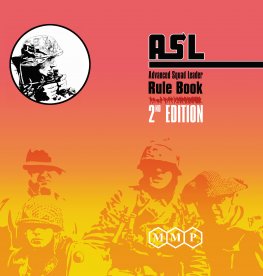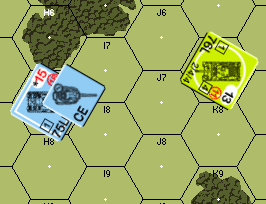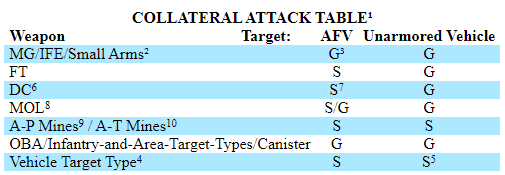
A recent Q&A answered by Perry and subsequently amended shows there is some confusion around this topic. I admit, the rules on this are not helpful. They create confusion and make this topic harder than it needs to be. So let’s look at the rules and see how they work together to arrive at the correct answer.
Rules Dive

The first relevant rules appear in Chapter A. First, we have A8.2 which reads (in part): “If the attack includes a To Kill DR vs a vehicle, Residual FP is created in the same manner [EXC: If AP (unless fired by a MG), ATR, APCR, or APDS was used, or if a Dud (C7.35) resulted, no Residual FP is created].” Next is rule A8.22 which reads (in part): “A8.22… A Collateral Attack never leaves Residual FP but the attack that causes it may.” I added the bold text in A8.22 for emphasis. It is not part of the text in the rule book but is key to understanding when and how to place RFP.
The final rule is D.8. It reads (in part): “D.8 Collateral Attacks:… A Collateral Attack receives no increased benefit due to Multiple Hits, nor does it leave Residual FP (A8.2).” This rule is the confounding rule which makes everything so hard to understand. Saying the Collateral Attack (CA) leaves no Residual Fire Power (RFP) does not negate A8.22. The CA does not leave RFP but the attack causing the CA leaves RFP in the normal manner. No RFP is left in specific instances outlined in A8.2 and excerpted above.
In my personal rule book, I have removed the portion of D.8 suggesting a CA does not leave RFP as I find it confusing. I have left the reference to A8.2-.22 as it has everything I need to determine what RFP to leave. Doing this makes the rules clearer to me. The amended Q&A Perry provided supports this.1 Let’s look at some examples.
Example 1

Refer to the image at left. I will use this for all the following examples. The American AFV fires AP at the Panther using Vehicular Target Type (VTT) and hits. The 76L’s TK# is only a 17 and has little chance against the Panther’s frontal armor and bounces off. Now, per D.8, conduct a Specific Collateral Attack (SCA) against the vulnerable PRC. This attack uses HE Equivalency (C8.31) to conduct a 2 FP shot against the exposed Crew. The applicable DRM is the CE status (D.8A). The 2 +2 isn’t much, but at least it is another chance to damage the Panther.
But what about RFP? Even though D.8 suggests there is no RFP, per A8.22, the attack that caused the SCA can leave RFP. However, we still need to look at A8.2 which specifically prevents AP from leaving any RFP when part of a SCA. So, this attack leaves no RFP.
Example 2
Again, refer to the image in Example 1. Knowing he has little chance, the American unit instead opts to fire an HE round using VTT. Again, the Sherman hits the Panther. This time, the TK# for a 76L HE shell is 10. The American tank cannot destroy the Panther. Again, the attack causes a SCA resulting in a 12 FP attack with only the +2 CE DRM (D.8A). Compared to Example 1, there is less chance to hurt the vehicle but a greater chance to hurt the CE crew.
What about RFP? The same rules apply as before only this time, HE is not an exception in A8.2. This attack leaves 4 RFP even though it results from an attack specifically targeting the AFV. Why 4 RFP? The Sherman has a +1 BU To Hit DRM which shifts the resulting RFP one column to the left. The SCA does not leave RFP but the attack CAUSING the SCA can.

Example 3
In our final example, we again refer to the image in Example 1. The Sherman fires HE at the Panther using Area Target Type (ATT). This attacks the AFV first per C1.55. If the AFV is unharmed by the attack, attack the vulnerable PRC with a 6 FP +2 CE DRM via a GCA.
Again, the CA does not leave RFP (D.8) but the attack that CAUSES the CA does (D8.22). The attack leaves 1 RFP. The 6 FP attack normally leaves 2 RFP, but the +1 BU To Hit DRM for the Sherman again shifts the RFP one column to the left.
It is worth mentioning that D.8B is a little stretched when a vehicle is attacked via ATT, especially during the MPh. Clearly, to shoot ATT at a moving vehicle you have to predesignate the AFV as the target. Fortunately, the chart in D.8 (Figure 1) is pretty clear about the resulting GCA from an original ATT attack.
Conclusion

I hope this short article clears up any confusion around collateral attacks and RFP. If you take away only one thing, I recommend you simply change your D.8 as I have. It makes it so much easier to understand how to play this properly. I hope you find it useful too. Until next time. – jim
QUESTION #3: Does the squad/FG which conducts a Specific Collateral Attack vs vulnerable PRC because of a MOL attack leave Residual FP (RFP)?
(I am thinking, Yes & No; because of rule D.8, even though rule A22.612 does not refer to rule D.8, I am thinking the 4 FP of the MOL does NOT leave any RFP but the Small Arms does.)
{If the use of a MOL attack disallows leaving RFP even from the Small Arms / IFP, this is counter intuitive to me.} A:The original Small Arms-MOL attack leaves RFP, not the Specific Collateral attack.
QUESTION #4: If the answers to Q1 & Q3 are yes - is the IFP of the squad halved as if conducting an attack vs a Concealed unit for RFP purposes?
A: No.
....Perry MMP


Thank you for this. I find Collateral Attacks to be one of the hardest things for me to grok, as it were. I may still be a bit wound about the axle re: specific and general.
In the end, I just shrug my shoulders and roll boxcars and be done with it 😉
Well, to me, the lesson is that the attack causes the RFP so you can basically ignore D.8.